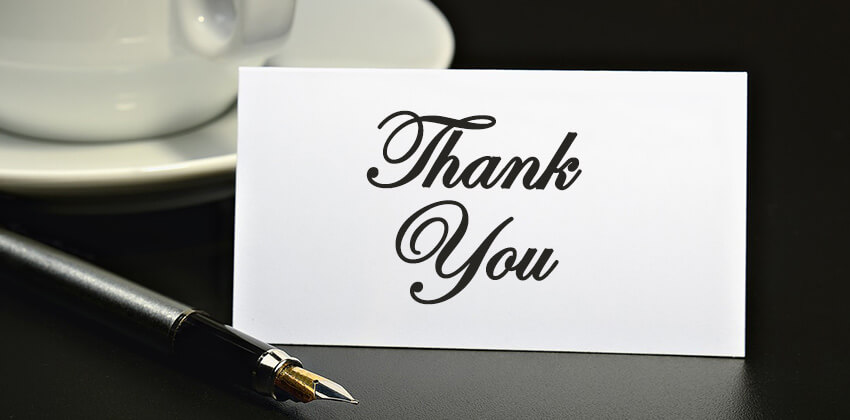Writing A Thank You Note After An Interview

Although recent surveys show that most employers seem to be happy receiving a thank you by email, this is the thank you that you put into an envelope, add a stamp, and drop off at the Post Office.
For the employer, this note is a "sample" of your work.
Keep it short (less than one page), but personalized.
Typically, as with email, you send a separate (and unique) thank you to a each member of the employer's staff who interviewed you. Also send a different thank you to an external recruiter, if one referred you to the job.
NOTE: If an external recruiter referred you, ask them which thank you is most appropriate for the employer, including whether email is appropriate and acceptable by this employer.
When to Send a Formal Interview Thank You Note
Email arrives immediately, assuming you have the correct email address and your message does not get caught in a spam filter. So, unless the employer really seems to dislike technology (and you didn't receive an email from anyone at this employer setting up the interview or see anyone using a computer while you were there), often the best strategy is start with email and follow-up with a formal paper thank you note.
If appropriate, send the email thank you as soon as you get home. Then, follow up with the formal thank you as soon as possible after that.
When you send a formal thank you letter through the mail service, assume that it may take several days to reach the recipient, particularly in large organizations where mail is first sorted in a mail room and then distributed throughout a large facility. So, don't wait!
Write this thank you note after then interview. Then, drop this thank you note into the mail as soon after the interview as possible, preferably by the next day.
If you forgot to send this note until a week (or more) after the interview, send it anyway. Hopefully, you sent an email thank you immediately, which should be sufficient for most employers.
Two Basic Formats for Formal Thank You Notes
You have two options for sending formal thank you notes.
1. Handwritten Thank You Notes
Some old, very traditional organizations — and traditional people — will expect handwritten notes, done very carefully and as legibly as possible. [Jump to: Sample Handwritten Thank You Note]
2. Printed Thank You Notes
A word-processed note printed by a computer printer is usually acceptable in most organizations today. It's also usually much more legible. [Jump to: Sample Printed Thank You Note]
Choose the format that seems most appropriate for the organization unless your handwriting is illegible. If no one can read your writing, use your computer to send the printed version.
See the sample printed and handwritten thank you notes below on this page or the Sample Job Interview Thank You Email for comparison.
How to Write a Thank You Note After an Interview
Prepare in advance and treat the thank you note as a task that can demonstrate your professionalism. You want your thank you notes to make a positive impression, and support your candidacy for the job.
1. Send to the correct name and addresses.
Hopefully, you collected business cards from the people who interviewed you, so you have the correct spelling for the person's name plus their snail mail address. If you are not sure, Google the business name, and look for business directories or contact the recruiter or HR staff members (very apologetically).
Note that some people may have traveled from another location to interview you, so worst case (avoid if possible!), call the recruiter and ask for the correct addresses for each person.
2. Use good quality thank you notes or paper.
If you are going to hand write your note, use standard thank you notes you find in a stationery/card store. Don't use fancy and flowery cards unless they are appropriate for the business (like a florist), and avoid very small cards since that will limit your ability to include sufficient information.
Thank you notes typically fold in half with "Thank you" on the top and the inside blank. Hand write your thank you on the bottom half or the right half of the inside of the note, depending on how the card works, so that your note is immediately visible without having to turn the card to view it when opened.
If you are sending a word processed note, be sure to have good quality paper in your printer with, hopefully, matching envelopes for you to use.
3. Don't just copy the emailed thank you.
If you sent an email note, don't paste it into your word processor and click print. Unfortunately, the content of the physical thank you and the electronic thank you must be different. The difference doesn't need to be dramatic, but it needs to be real.
4. Send a unique thank you note to each person.
Assume that, like emailed thank you notes, the physical notes will be shared and compared, too. So, sending the same note to each person is not a good idea! You'll look lazy and a bit cheesy — not a good impression to give.
5. Address the note correctly.
Be sure that you are spelling each person's name correctly. I've met so many people with names spelled differently — Jenifer (vs. Jennifer) and Jon (vs. John).
I happen to have two first names — "Susan" and "Joyce" — and people who address me as "Joyce" clearly aren't paying very close attention. Don't make that mistake.
6. Match the right card with the right envelope.
Be sure to put Mary Smith's thank you into the envelope addressed to Mary Smith, not into the envelope addressed to Bill Jones.
7. Include a return address on the envelope.
Worst case, if your card isn't deliverable, you will know when the Post Office returns it to you.
Include your business card in the thank you note, just in case the recipient doesn't remember you. The business card also makes it very easy for the recipient to reach out to you without going to the trouble of digging out your resume or application.
Sample Post-Interview Thank You Notes
Use these as samples as guides. Customize them to your own situation.
Sample Printed Thank You Note
If you are using your computer to write, print, and send your thank you, write a one-page letter (99% of the time one page is sufficient).
Adapt the text in the sample to your circumstances, and customize it as described in Sending Your Thank You's After the Job Interview. Replace the Italicized text in the sample below with whatever terms are appropriate for you and your situation.
Use the formal business letter format like this:
Your street address
Your City, State and Zip Code
Date of the letter
Name of the Recipient
Job Title of the Recipient
Name of the Employer
Employer's Street Address
Employer's City, State and Zip CodeDear Mr./Ms Last Name:
Thank you very much for the opportunity to interview for the position of [job title] yesterday [or today, if appropriate]. I enjoyed speaking with you, meeting other members of the staff, and the opportunity to learn more about this position. I am very interested in this position and the opportunity to join your team.
This job feels like a very good match between my skills and experience and the requirements of this job. As we discussed, you need someone with strong [whatever] skills, and I have extensive experience with [whatever technology or tool that is important to the job and that you have experience using]. In addition, in my current [or former] job as [names or type of employer in your past] has provided the opportunity to polish my skills in [whatever] and [whatever] needed for your [job title] position.
Again, thank you for considering me for this wonderful opportunity. Please let me know if you have any questions or concerns or need more information. I look forward to hearing from you next week [or whenever they said they would be in touch] and hope to join your staff soon.
Best regards,
[your name]
[Your tag line, like "eCommerce Customer Support Specialist"]
[Your job search email address]
Sample Handwritten Thank You Note
The good news about a handwritten thank you is that you won't have much space to fill, so it can be much shorter. Avoid the instinct to write a long message. When you crowd too much handwriting into a small space, legibility and comprehension can be lost.
The bad news is that you need to write very carefully so the note can be easily read — a harder task these days when most of us spend our time typing on a keyboard. Write the note on a piece of paper before you write it on a card to be sure it will fit and is legible.
Date of the letter
Dear Mr./Ms Last Name,
I appreciate your time and the information you shared in my interview on [date] for the [job title] position. I am very interested in this job and in becoming a contributor to your organization.
I believe my experience as a [whatever] where I [name a relevant accomplishment or work] will enable me to hit the ground running in this position.
[OR, I believe my training as a [whatever] where I learned [a specific skill required for the job] will enable me to hit the ground running in this position.]Please contact me if you have any questions. I look forward to hearing from you soon. Thank you, again, for your time.
Best regards,
[Your full name]
Choose your words carefully and double-check the spelling of anything you are not 100% sure of. When you hand write a note, you don't have a built-in spell check to keep you from embarrassing yourself with bad spelling.
After the Thank You Notes Are Sent
If you don't hear from them for a couple of weeks longer than you expected, don't panic. MUCH could be going on that has nothing to do with you at all. But do reach out to see what is happening. Do NOT contact them daily — or even weekly — for a decision.
NEVER suspend your job search while you wait for a decision from an employer, even if the job is your dream job.
Restarting your job search can be challenging and, if you've been turned down, you may be more discouraged because you need to re-start your momentum.
 About the author…
About the author…
Online job search expert Susan P. Joyce has been observing the online job search world and teaching online job search skills since 1995. A veteran of the United States Marine Corps and a recent Visiting Scholar at the MIT Sloan School of Management, Susan is a two-time layoff "graduate" who has worked in human resources at Harvard University and in a compensation consulting firm. Since 1998, Susan has been editor and publisher of Job-Hunt.org. Follow Susan on Twitter at @jobhuntorg and on Facebook, LinkedIn.
More about this author…
Writing A Thank You Note After An Interview
Source: https://www.job-hunt.org/sample-interview-thank-you-notes/
Posted by: lynchsweend1940.blogspot.com

0 Response to "Writing A Thank You Note After An Interview"
Post a Comment